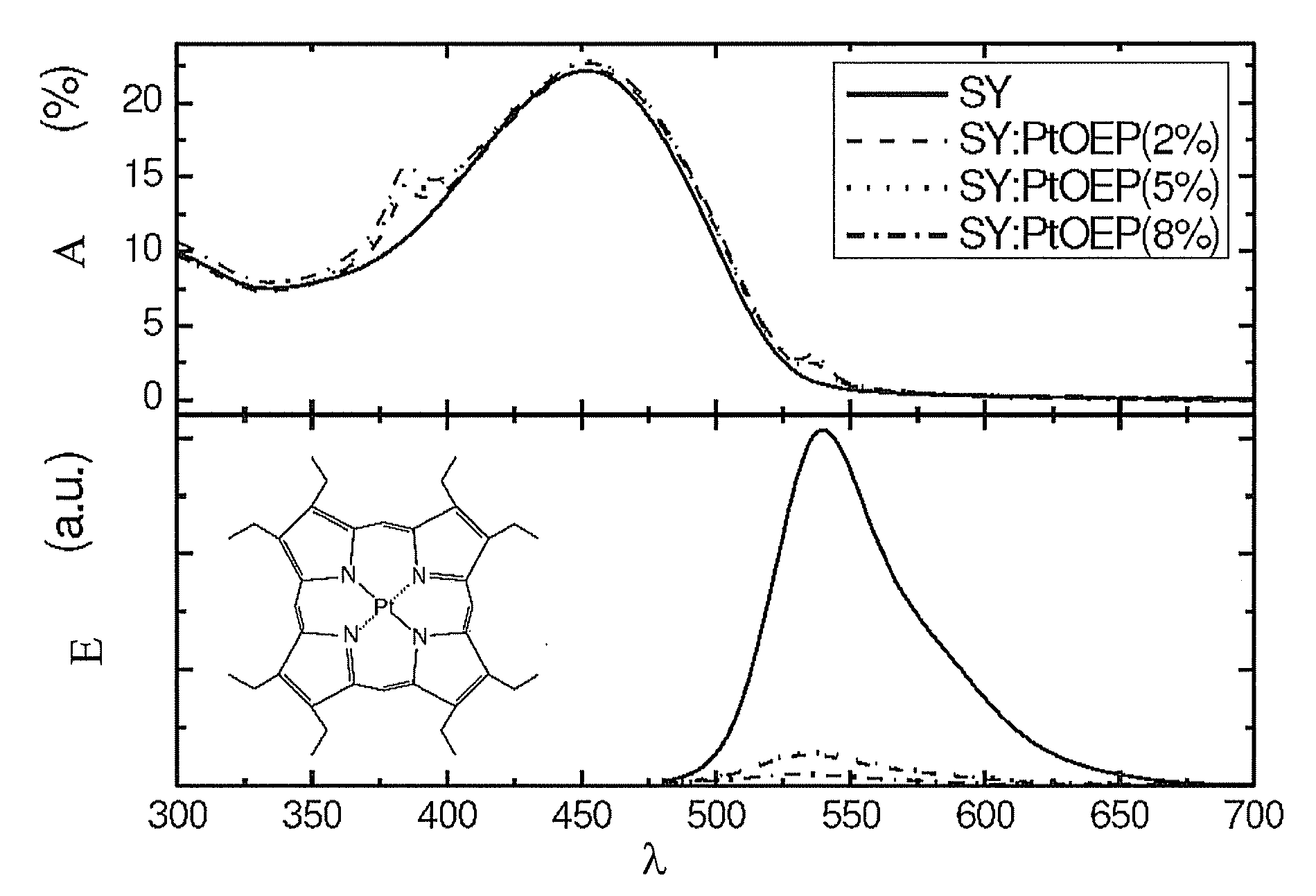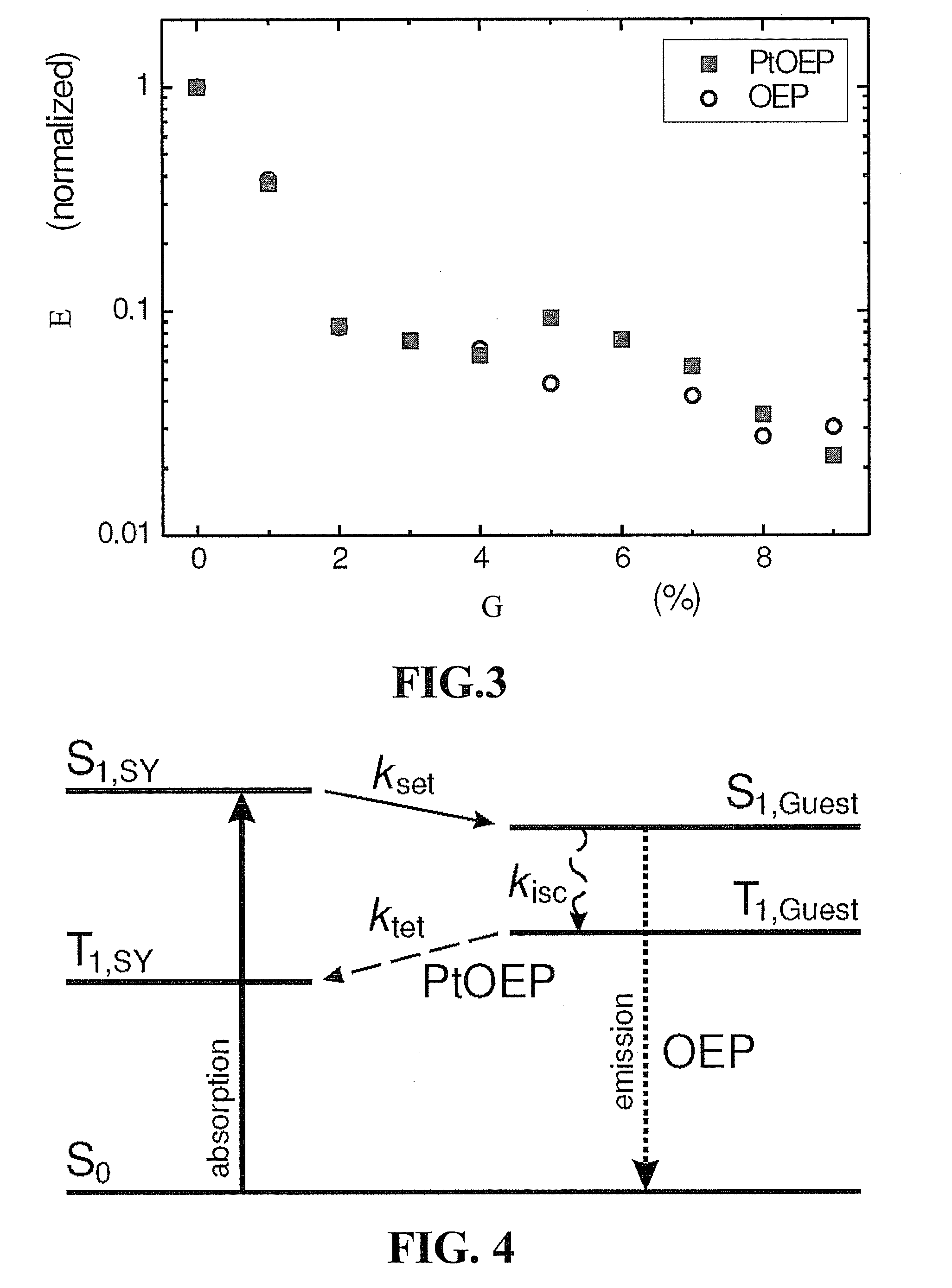Photovoltaic Structures and Method to Produce the Same
a photovoltaic and structure technology, applied in the field of organic optoelectronics, can solve the problem of difficult to achieve a very fine phase separation between the electron donor material and the donor material
- Summary
- Abstract
- Description
- Claims
- Application Information
AI Technical Summary
Benefits of technology
Problems solved by technology
Method used
Image
Examples
example 1
Investigation of the Usability in Embodiments of the Present Embodiment of a SY:PtOEP host:guest System in a Donor Material
[0189]As an example the phenyl-substituted poly(p-phenylene vinylene) (PPV) donor polymer Super Yellow (SY) obtainable from Merck OLED materials GmbH (see formula (I)) doped with the phosphorescent molecule platinum octaethylporphyrin (PtOEP) (see formula II) is used.
[0190]Furthermore, the effect of doping with the Pt-free analogue of (II) octaethylporphyrin (OEP) (III) was investigated to demonstrate the opposite effect: a dopant that allows singlet energy transfer (SET) but not triplet energy transfer (TET) is expected to actually reduce the photocurrent.
[0191]FIG. 1 shows the absorption and emission of a pure SY (I) film as well as films doped with PtOEP (II), whereas FIG. 2 shows SY (I) films doped with OEP. The absorption shoulders of PtOEP (II) and OEP (III) are present in the doped films, at wavelengths of λ=385 and 535 nm for PtOEP (II) and at λ=410 nm f...
example 2
Investigation of the Usability in Embodiments of the Present Embodiment of a MEH-PPV:PtOEP host:guest System in a Donor Material
[0192]FIG. 5 shows the absorption and emission of a pure MEH-PPV (VI) film (curves A and A′ respectively) as well as films doped with PtOEP (II) (curves B and B′ respectively). The absorption shoulder of PtOEP (II) is present in the doped films, at the wavelength of λ=385 nm. The MEH-PPV (VI) emission, with its peak at λ=562 nm, is quenched as a result of the introduction of the guest PtOEP (II). Indeed, as shown in FIG. 5, the MEH-PPV (VI) emission is decreased to about 12% of its initial value upon the addition of 5% PtOEP (II) in the polymer matrix. Perhaps most importantly, however, is that PtOEP (II) phosphorescence at λ=650 nm is not present. This suggests a similar excitonic pathway to that illustrated schematically in FIG. 4, where for the case of PtOEP (II) there is efficient SET from MEH-PPV (VI) to PtOEP (II) molecules, followed by ISC, and final...
example 3
Investigation of the Usability in Embodiments of the Present Embodiment of a MDMO-PPV:PtOEP host:guest System
[0193]FIG. 6 shows the absorption and emission of a pure MDMO-PPV (V) film (curves C and C′ respectively) as well as films doped with PtOEP (II) (curves D and D′ respectively). The absorption shoulder of PtOEP (II) is present in the doped films, at the wavelength of λ=385 nm. The MDMO-PPV (VI) emission, with its peak at λ=567 nm, is quenched as a result of the introduction of the guest PtOEP (II). Indeed, as shown in FIG. 6, the MDMO-PPV (VI) emission is decreased to about 32% of its initial value upon the addition of 5% PtOEP (II) in the polymer matrix. Perhaps most importantly, however, is that PtOEP (II) phosphorescence at λ=650 nm is not present. This suggests a similar excitonic pathway to that illustrated schematically in FIG. 4, where for the case of PtOEP (II) there is efficient SET from MDMO-PPV (VI) to PtOEP (II) molecules, followed by ISC, and finally TET back to M...
PUM
| Property | Measurement | Unit |
|---|---|---|
| Molar mass | aaaaa | aaaaa |
| Weight ratio | aaaaa | aaaaa |
| Structure | aaaaa | aaaaa |
Abstract
Description
Claims
Application Information
 Login to View More
Login to View More - R&D
- Intellectual Property
- Life Sciences
- Materials
- Tech Scout
- Unparalleled Data Quality
- Higher Quality Content
- 60% Fewer Hallucinations
Browse by: Latest US Patents, China's latest patents, Technical Efficacy Thesaurus, Application Domain, Technology Topic, Popular Technical Reports.
© 2025 PatSnap. All rights reserved.Legal|Privacy policy|Modern Slavery Act Transparency Statement|Sitemap|About US| Contact US: help@patsnap.com



